Overview
We assert that the nine principles of application integration architecture are crucial for successfully unifying systems and data. These principles—defining clear objectives, implementing strong governance, ensuring real-time monitoring, and embracing continuous improvement—are not merely theoretical; they are substantiated by evidence and examples that demonstrate their ability to enhance operational efficiency, compliance, and adaptability across various industries.
What challenges are holding your organization back from realizing these benefits? By understanding and applying these principles, we can transform your operational landscape, ensuring that your systems work in harmony.
Let us guide you in this journey toward seamless integration and improved performance.
Introduction
In an era defined by the necessity of seamless connectivity, we at Avato position ourselves as a transformative force in the domain of hybrid integration platforms. Our innovative methodology not only simplifies the intricate processes of integrating diverse systems and data but also significantly boosts operational efficiency across critical sectors such as banking, healthcare, and government.
With a robust architecture tailored to adhere to stringent security and compliance standards, we empower organizations to fully leverage their legacy systems while minimizing downtime. As businesses navigate the complexities of rapidly evolving technologies and market demands, our capabilities distinctly stand out, heralding a future where integration transcends mere necessity to become a strategic advantage.
What’s holding your team back from realizing this potential? Let us guide you toward a more integrated and efficient future.
Avato: Secure Hybrid Integration Platform for Modern Architecture
We stand at the forefront of hybrid platforms, transforming the application integration architecture that businesses utilize to link their systems and data. Our strong focus on securely and efficiently uniting previously fragmented and incompatible technologies through application integration architecture has established us as leaders in the unification sector. Our platform supports 12 levels of interface maturity, allowing organizations to strike a balance between speed and sophistication in their projects. Key features include real-time monitoring and alerts on system performance, enabling businesses to unlock data and systems within weeks rather than months. This capability is essential for reducing downtime and guaranteeing continuous availability for critical connections.
Especially beneficial for industries like banking, healthcare, and government, our solution addresses the urgent requirement for secure and dependable connectivity. The platform’s robust application integration architecture is specifically designed to meet the stringent regulatory compliance and security audit requirements that are essential in these industries. Our hybrid platform not only simplifies complex connections but also maximizes and extends the value of legacy systems, significantly lowering expenses while enhancing operational capabilities.
As of 2025, the uptake of hybrid platforms in banking has experienced substantial growth, propelled by the need for agility in adapting to changing market demands. Expert opinions highlight our ability to simplify complex projects, with customers like Gustavo Estrada noting, ‘Avato has simplified complex projects and delivered results within desired time frames and budget constraints.’ This combination of speed, security, and simplicity ensures that businesses remain competitive in their respective markets. What’s holding your team back? Let us help you navigate these complexities and unlock your potential.
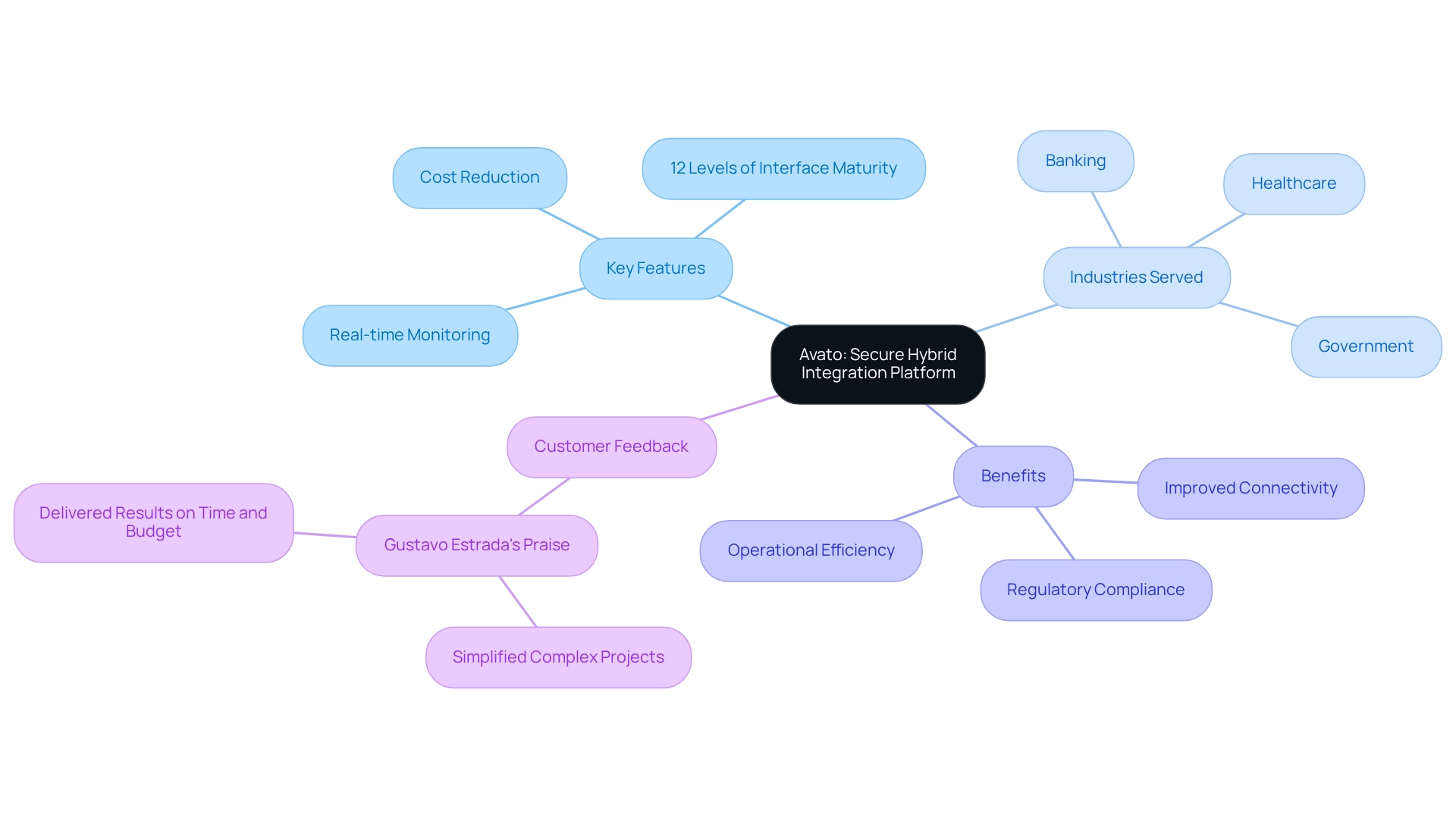
Principle 1: Define Clear Integration Objectives and Goals
Establishing clear unification objectives and goals is essential for our successful application integration architecture. We must pinpoint specific outcomes we aim to achieve, such as enhancing data accessibility, improving operational efficiency, or ensuring regulatory compliance. By employing the SMART criteria—Specific, Measurable, Achievable, Relevant, and Time-bound—we can establish a focused roadmap that not only guides our collaborative efforts but also aligns stakeholders around common objectives.
The importance of clear collaboration goals is underscored by the fact that, as of 2020, 65% of organizations had adopted SMART criteria as a foundational tool for performance management. This structured approach has proven effective across various sectors, including manufacturing, where companies that implemented SMART goals reported streamlined operations, reduced costs, and improved product quality. Comparable principles are relevant in the banking industry, where clear unification goals can lead to improved operational efficiency and compliance, particularly in relation to preparing for open banking.
In the banking industry, the impact of clearly defined unification goals is especially noticeable. Organizations that establish clear objectives achieve greater success rates in their merger projects. This is supported by the fact that 83% of companies recommend the OKR framework for aligning company goals and improving outcomes. While SMART goals offer a strong foundation, the OKR framework can enhance these aims by ensuring that initiatives are not only efficient but also aligned with wider business objectives. By committing to SMART goals, we can pave the way for lasting success in our unification efforts, particularly as we navigate the complexities of open banking and seek to optimize our strategies with Avato.
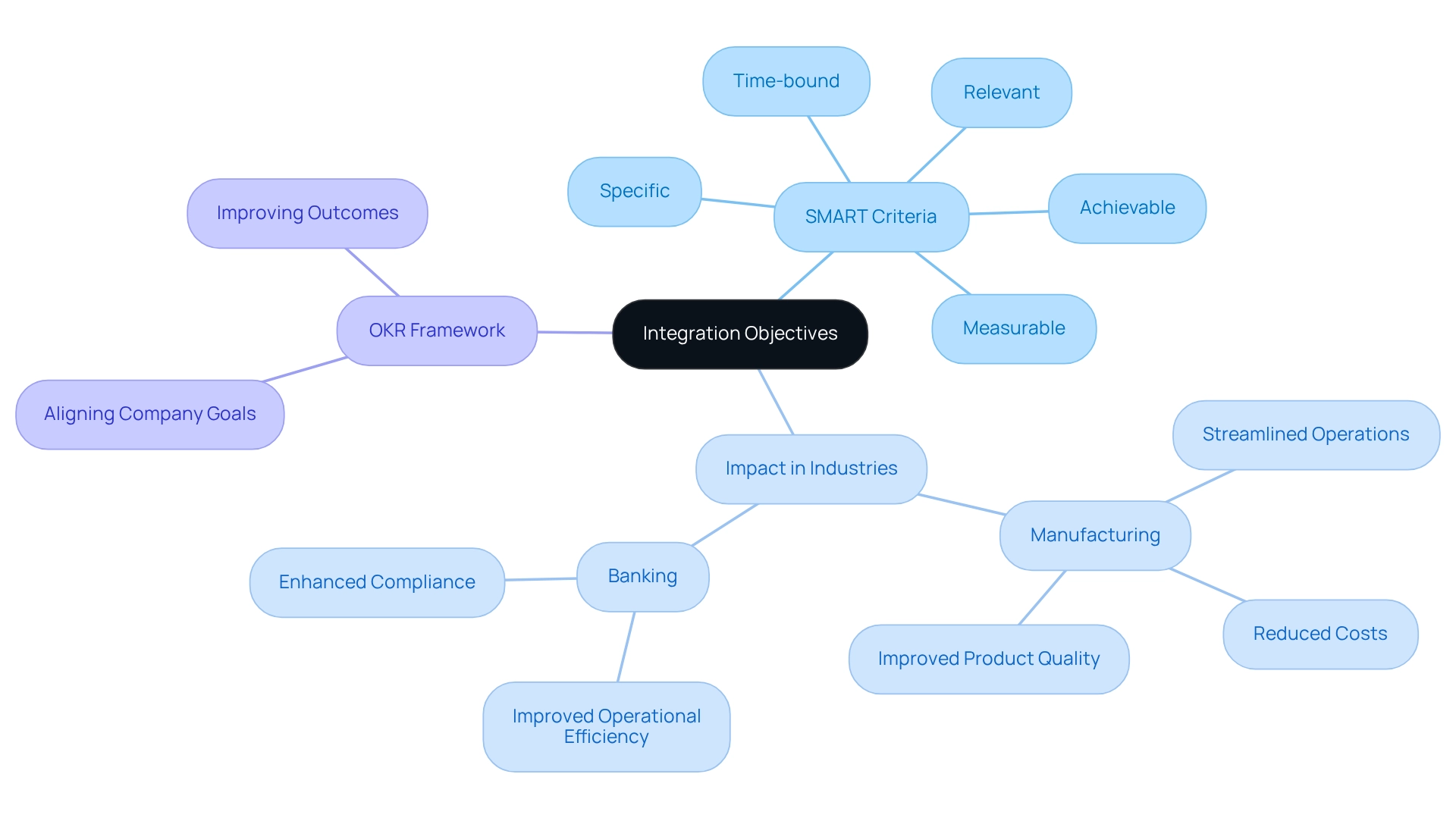
Principle 2: Implement Strong Governance and Compliance Measures
Establishing robust governance and compliance measures is paramount for preserving the integrity of our unification processes. We must implement clear policies governing data access, usage, and sharing to ensure adherence to regulations such as GDPR and HIPAA. Routine audits and evaluations are essential for recognizing vulnerabilities and ensuring that our incorporation practices align with organizational standards. This proactive approach not only safeguards sensitive information but also bolsters stakeholder confidence.
Statistics reveal that 42% of companies have seen tangible benefits from investments in privacy measures, which directly correlates to improved governance and compliance in their application integration architecture. By prioritizing these investments, we can enhance our operational efficiency and mitigate risks related to information handling.
Furthermore, compliance officers typically dedicate 1 to 7 hours weekly to track regulatory developments. This time investment is critical as it translates into better governance practices, ensuring that we remain compliant with evolving regulations and standards.
Organizations that emphasize employee education on compliance matters have shown a notable decrease in the financial impact of breaches, averaging $260,000 less in expenses compared to those lacking such training. This demonstrates the essential connection between governance, compliance, and risk management in data merging, highlighting the necessity for thorough training programs.
As we navigate the complexities of compliance, leveraging application integration architecture becomes imperative. Our hybrid unification platform, backed by a worldwide network of skilled collaboration partners, enables us to adopt effective compliance strategies. By embracing these tools and staying updated on the latest strategies, we can enhance our unification framework while protecting our reputation and operational integrity. As Sharavanan, Associate Product Marketing Manager, mentions, “By adopting these tools and keeping up with new trends, we can equip ourselves to manage the complexities of compliance efficiently and protect our reputation, information, and operations in the future.
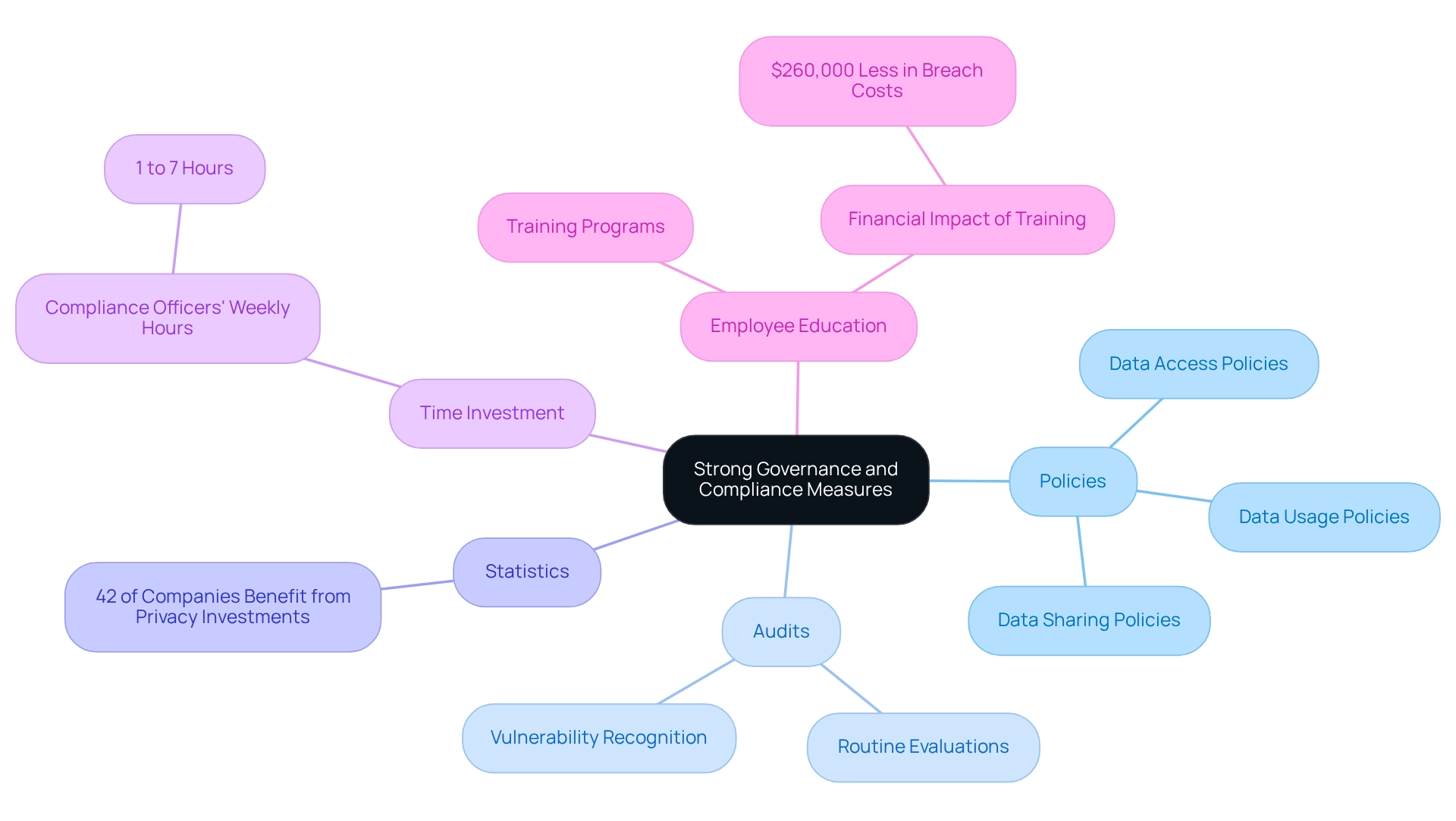
Principle 3: Ensure Real-Time Monitoring and Performance Management
Real-time monitoring and performance management are indispensable for successful application unification, particularly in sectors such as banking, healthcare, and government. We must implement monitoring tools that provide comprehensive insights into system performance, data flow, and overall connectivity health. Our Hybrid Platform excels in this area, enabling teams to maximize and extend the value of legacy systems while simplifying complex connections. By setting up alerts for anomalies or performance declines, we can proactively address issues, ensuring that connections remain both dependable and effective. This proactive approach not only enhances operational efficiency but also fosters continuous improvement initiatives.
For instance, the implementation of robust API monitoring tools, such as those offered by Avato, provides real-time insights and customizable dashboards tailored to the needs of banking IT managers. These tools allow entities to closely monitor performance, enabling prompt actions when needed, which is essential in the highly regulated banking sector.
As the cloud market continues to grow, reaching an impressive $330 billion—largely fueled by advancements in generative AI—the need for efficient monitoring solutions becomes increasingly vital. This growth underscores the importance for banking IT managers to adopt advanced monitoring tools that can keep pace with evolving technologies and connectivity demands. Furthermore, with 55% of entities now employing AIOps for observability across network and security areas, understanding AIOps—an approach that utilizes artificial intelligence to enhance IT operations—becomes essential. AIOps can significantly enhance application integration architecture by automating monitoring processes and providing deeper insights into system performance. Our platform facilitates ongoing observation and enhancement through application integration architecture, ensuring robust analytical functionalities that assist companies in elevating customer experiences and uncovering new avenues for innovation. To achieve successful incorporation projects, banking IT managers ought to evaluate monitoring tools based on their ability to deliver real-time insights, scalability, and user-friendliness within the context of application integration architecture. By effectively utilizing performance management tools, we can enhance the reliability of our connections and align them with strategic objectives.
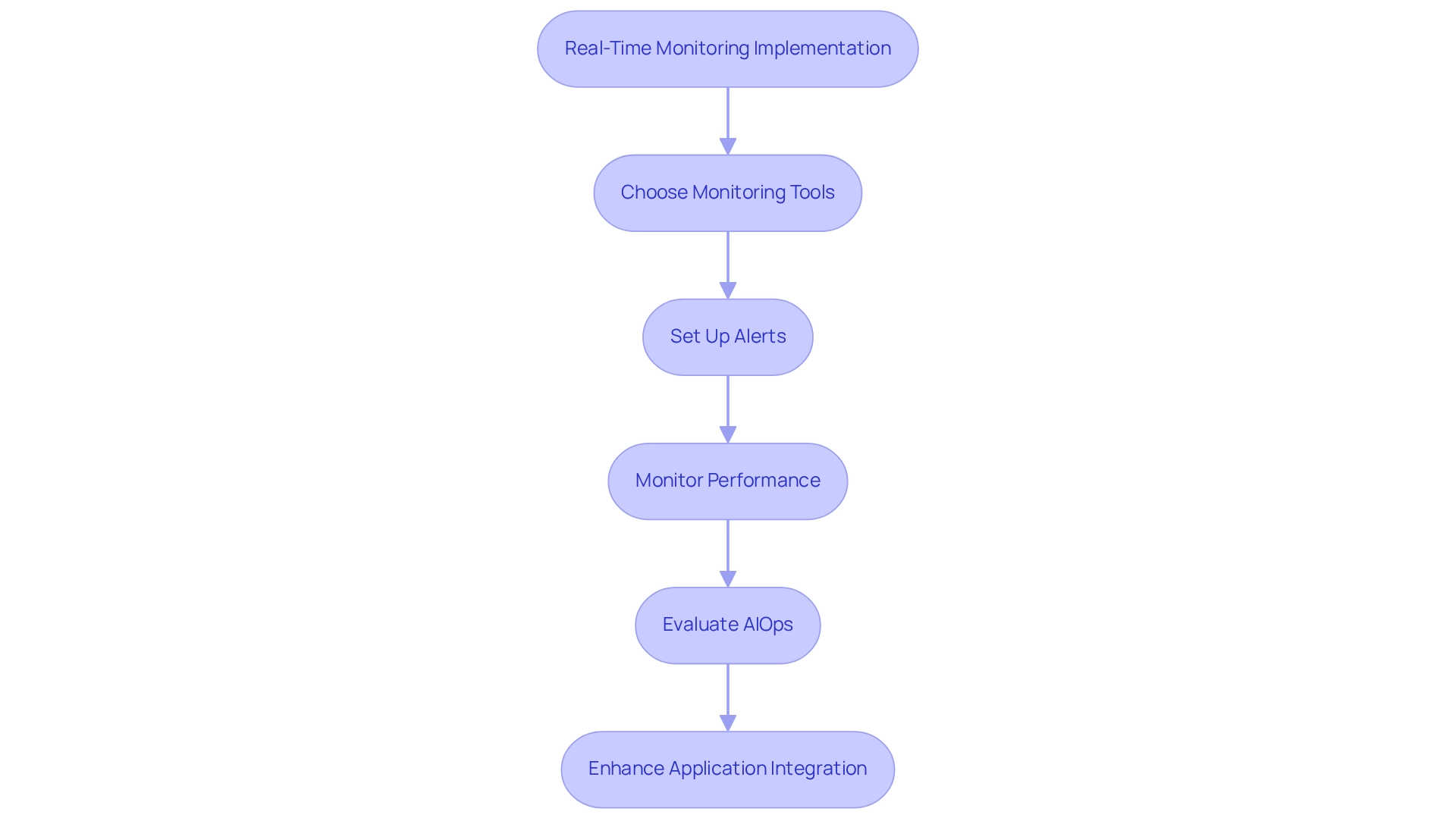
Principle 4: Adopt Standardized Protocols for Interoperability
Implementing standardized protocols for interoperability is not just beneficial; it is essential for effective application integration architecture. We recognize that organizations must utilize industry-standard protocols such as REST, SOAP, and GraphQL to facilitate seamless communication between disparate systems. By standardizing information formats and communication methods as part of our application integration architecture, we can significantly reduce the complexity of merging and enhance exchange capabilities. This approach not only improves overall system compatibility but also leads to more efficient operations.
REST (Representational State Transfer) and SOAP (Simple Object Access Protocol) are two widely used protocols that offer distinct advantages in system interoperability. REST is recognized for its simplicity and lightweight characteristics, making it perfect for web services that require quick and efficient information exchange. In contrast, SOAP provides a more robust framework with built-in error handling and security features, which is particularly beneficial in regulated industries such as healthcare and finance.
The adoption of these standardized protocols has been shown to improve interoperability within the application integration architecture, especially in legacy systems where integration challenges are prevalent. XML, as a formal and open specification, plays a vital role in this context. It separates information access from the software that generates and utilizes it, ensuring that the information remains functional despite technological changes. This adaptability is crucial for organizations looking to future-proof their operations.
Consider the considerable extent of health information sharing by diagnostic vendors in the U.S. in 2022, which emphasizes the necessity for effective communication standards. What flexible assimilation strategies are you employing? Ongoing medical breakthroughs will require continual updates to electronic health record (EHR) data fields, as noted by Helsher.
Furthermore, the Office of the National Coordinator for Health Information Technology (ONC) has released metrics to evaluate interoperability, emphasizing how application integration architecture with standardized protocols can facilitate coordinated care and improve patient outcomes. Statistics indicate that organizations leveraging standardized protocols experience enhanced operational efficiency and reduced costs. By adopting REST, SOAP, and GraphQL, along with XML technologies, we can not only optimize our connection processes but also prepare ourselves to react quickly to changing market demands, ensuring we maintain a competitive advantage in our respective fields. As Gustavo Estrada, a client, remarked, “Avato has the capability to streamline intricate projects and provide outcomes within preferred timelines and financial limitations,” further confirming the efficiency of these unification strategies.
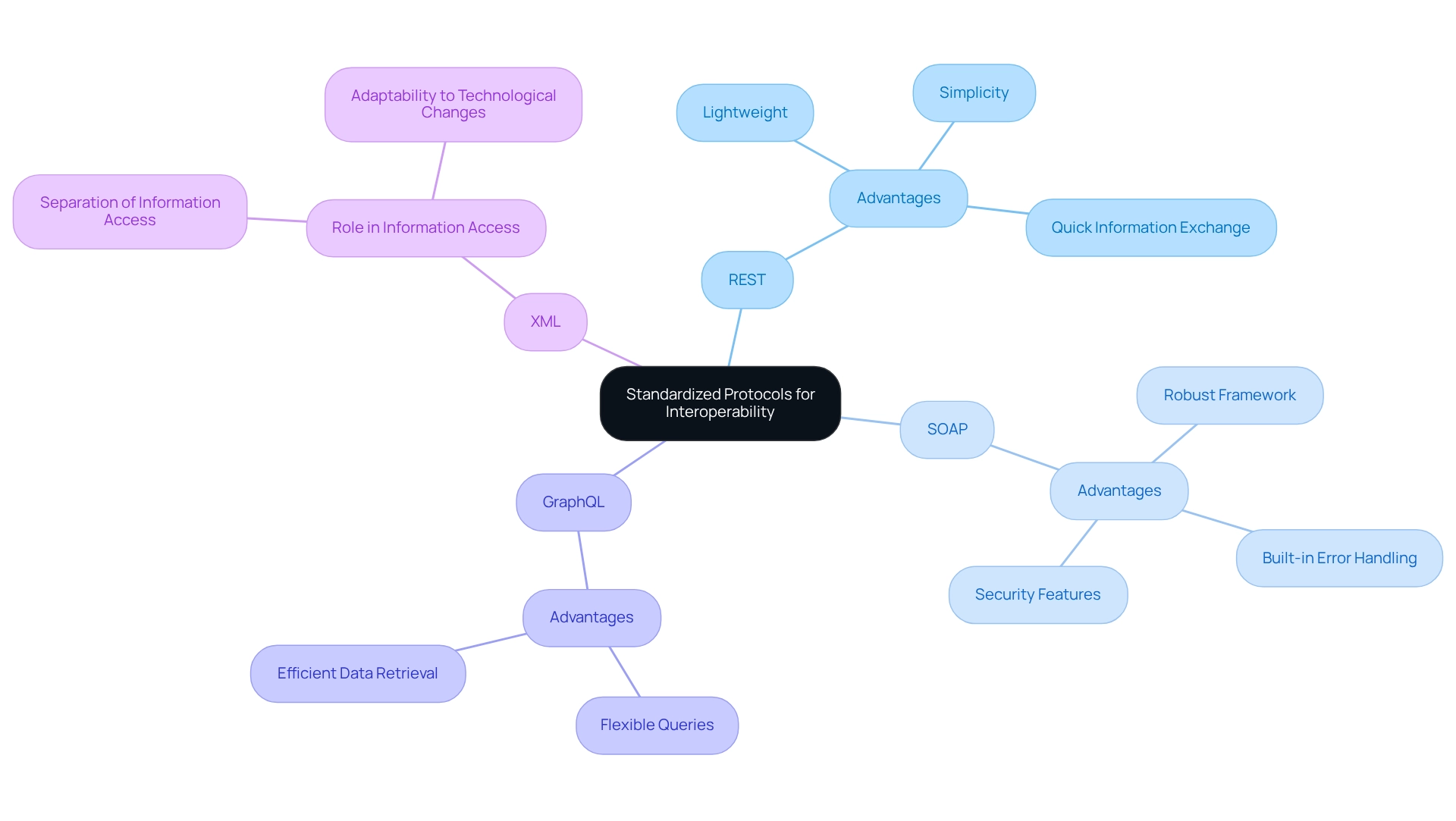
Principle 5: Design for Scalability and Future Growth
Designing for scalability and future growth is not just beneficial; it is essential in application integration architecture. We must create adaptable connection frameworks within our application integration architecture, which are capable of managing growing data volumes, accommodating additional applications, and adjusting to changing business requirements. By utilizing cloud-based solutions, modular architectures, and microservices, we facilitate effortless growth and adjustment as our business needs evolve.
Consider Avato’s Hybrid Platform, which exemplifies this method. It enables financial institutions to enhance and prolong the value of legacy systems while streamlining complex connections. This platform offers real-time monitoring and alerts on system performance, significantly lowering expenses and making it an ideal solution for organizations aiming to improve their connectivity capabilities.
Cloud computing has transformed business operations. In fact, 60% of organizations report increased revenue and enhanced service levels due to cloud capabilities. For instance, a financial organization that embraced cloud solutions experienced a 30% boost in transaction processing speed, showcasing the tangible advantages of scalable architectural designs. This shift underscores the necessity of cloud-based solutions for scalable connectivity, as 89% of companies acknowledge that application integration architecture is vital for their multi-cloud infrastructure. Automation simplifies processes and enhances our capacity to scale operations effectively, enabling us to react promptly to market demands. Moreover, the implementation of application integration architecture, particularly through microservices, has resulted in an impressive 200% rise in deployment frequencies, underscoring its efficiency in boosting operational effectiveness and scalability. By dividing applications into smaller, manageable services, we can utilize application integration architecture to scale individual components as required, ensuring optimal performance. For example, our collaboration with Coast Capital demonstrates how hybrid connection solutions can support various interfaces and facilitate significant system transitions with minimal downtime. Organizations that have adopted cloud solutions have not only enhanced their connectivity abilities but also strengthened their application integration architecture for future growth. As 83% of enterprise CIOs plan to repatriate some workloads in 2024, the significance of application integration architecture in designing scalable frameworks becomes even more pronounced. This trend suggests a shift towards hybrid models that necessitate strong coordination strategies to manage both on-premises and cloud environments effectively. By emphasizing scalability, we can guarantee that we remain competitive and adaptable to market needs.
Additionally, enforcing role-based access control, encrypting confidential information, and maintaining software with security updates are crucial steps to safeguard scalable architecture, especially in the banking industry where information protection is paramount.
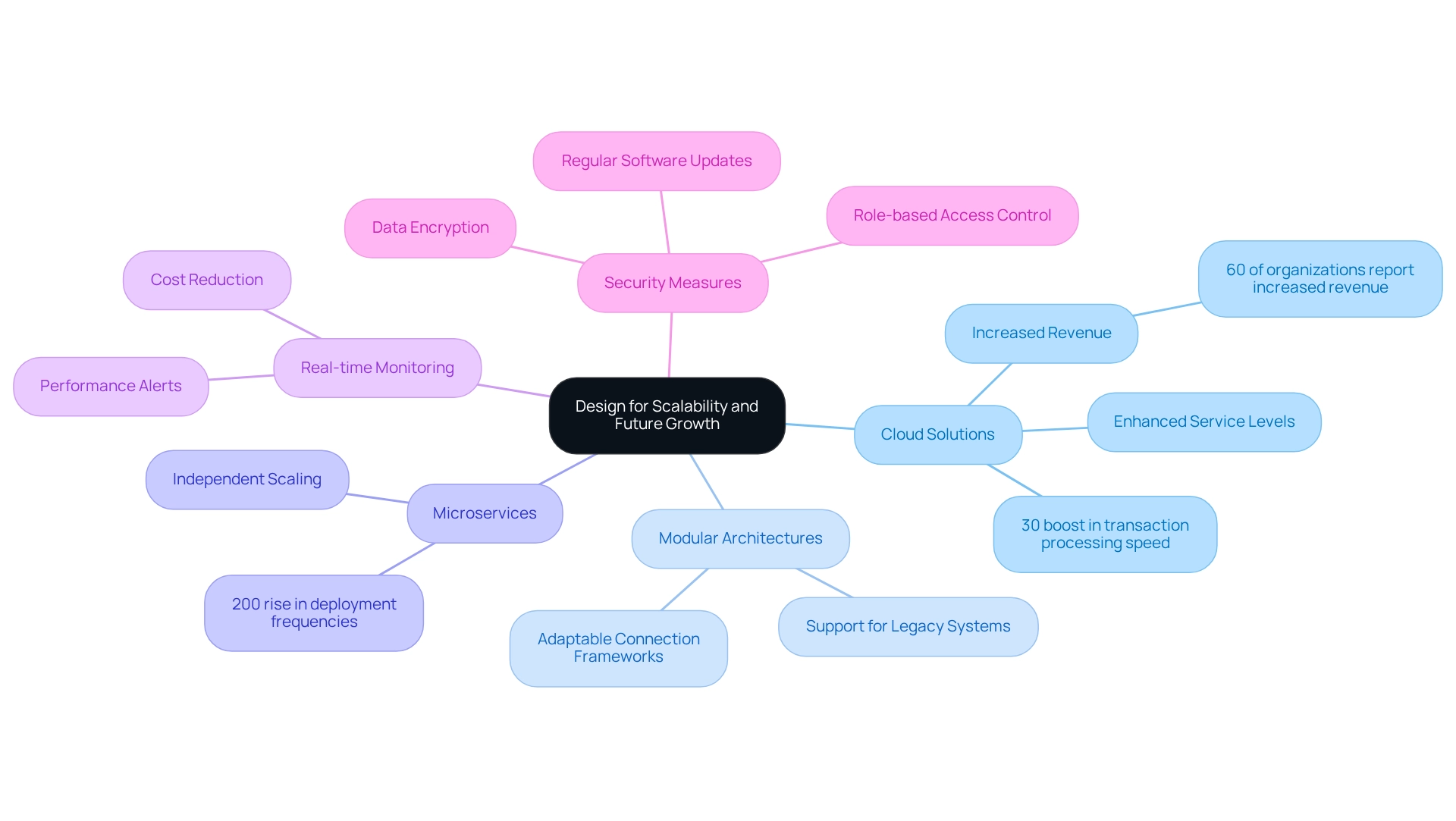
Principle 6: Incorporate Automation for Enhanced Efficiency
Incorporating automation into application integration architecture processes is vital for boosting efficiency and productivity. We can utilize connection platforms equipped with automation features to streamline data transfers, error handling, and reporting tasks. This reduction in manual intervention minimizes errors and accelerates processes, allowing our teams to allocate resources to more strategic initiatives, ultimately achieving significant operational effectiveness.
The transformative effects of workflow automation are evident across various sectors, with companies that embrace automation unlocking new efficiencies and improving collaboration. A recent study revealed that 74% of current users of AI in workflow automation plan to increase their investments in the next three years, reflecting a growing recognition of automation’s value. Furthermore, with automation and AI projected to contribute $15.7 trillion to the global economy by 2030, the potential for enhanced operational capabilities is immense, and our application integration architecture is crucial in this landscape by facilitating the elimination of manual tasks, thereby enhancing operational efficiency.
The platform enhances and expands the value of legacy systems while streamlining intricate connections, which is especially advantageous for financial institutions. For instance, our collaboration with Coast Capital exemplifies this, where the platform supported multiple interfaces and enabled major system transitions with minimal downtime. Customer reviews, like the one from Gustavo Estrada, highlight how we have streamlined intricate project tasks, achieving outcomes within preferred timelines and financial limitations. Additionally, the platform provides real-time monitoring and alerts on system performance, further enhancing operational efficiency. By minimizing manual processes in information transfers, we can optimize our operations and prepare for future success in a technology-driven environment.
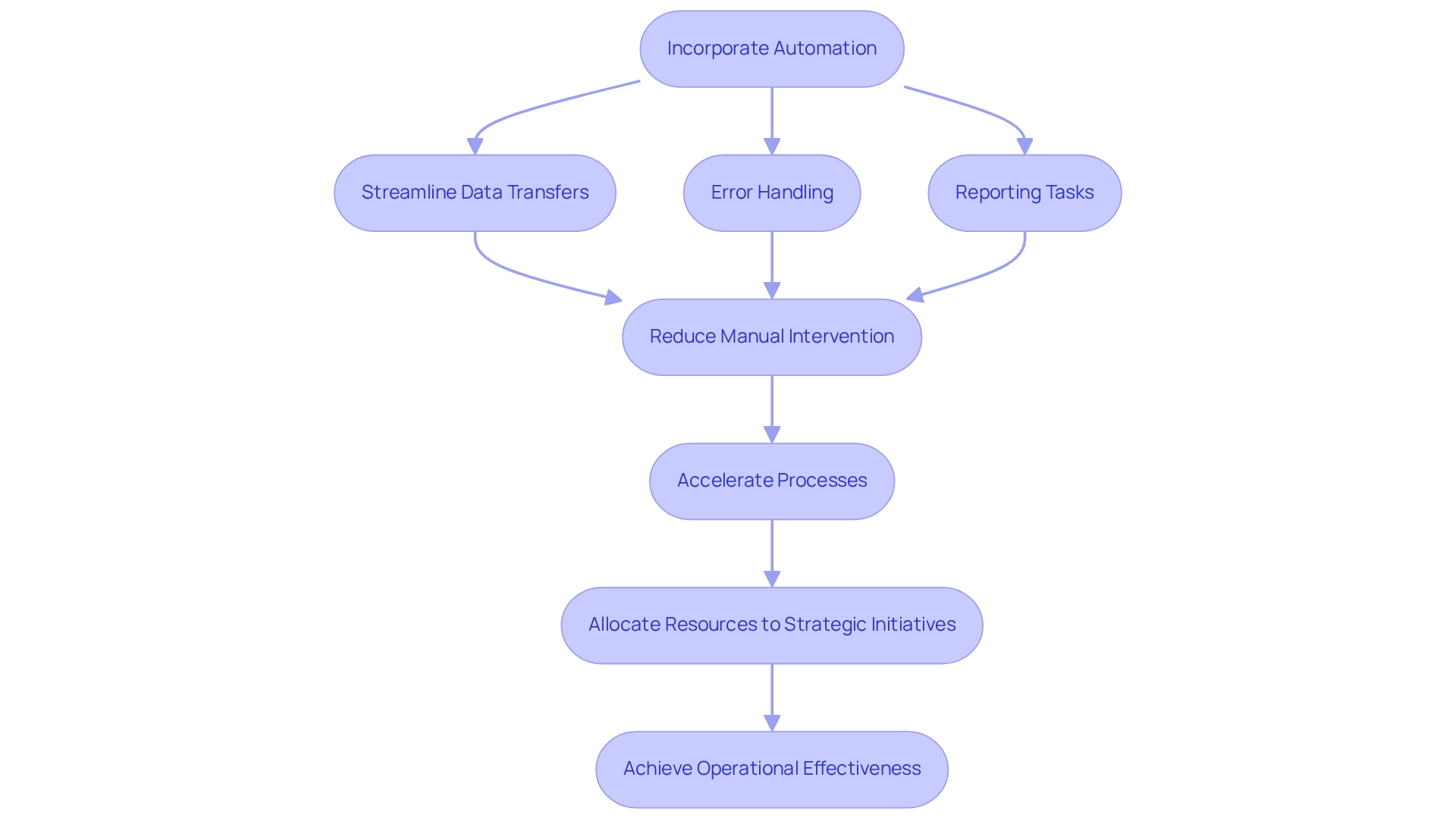
Principle 7: Prioritize Data Security and Privacy
Focusing on information security and privacy is not merely important; it is essential in application integration architecture. We must implement robust security protocols, including advanced encryption methods and strict access controls, to safeguard sensitive information throughout the incorporation process.
Our hybrid connection platform, supported by collaborations with managed service providers, is designed to mitigate risks associated with information breaches, ensuring compliance with regulations such as GDPR and HIPAA. This compliance transcends legal obligation; it is a critical component of maintaining user trust and organizational integrity.
With the healthcare sector facing the highest average breach costs at $9.8 million, the stakes are particularly high. By integrating security into our framework, we empower businesses to effectively reduce risks, enhance stakeholder confidence, and ensure a secure environment for information sharing.
As consumer willingness to share information for personalized experiences grows—77% of consumers are ready to share their email addresses—we must balance this with transparent practices to foster trust. We assist organizations in maintaining this clarity, ensuring that information sharing occurs ethically and securely.
In a landscape where security budgets have increased by approximately 8.6% over the last five years, investing in comprehensive data security measures through enterprise architecture and project management services is not just prudent; it is vital for sustainable growth. Moreover, with an anticipated 3.5 million unfilled cybersecurity positions worldwide, the necessity for organizations to invest in strong security measures is clear, aligning with our mission to provide secure connection solutions.
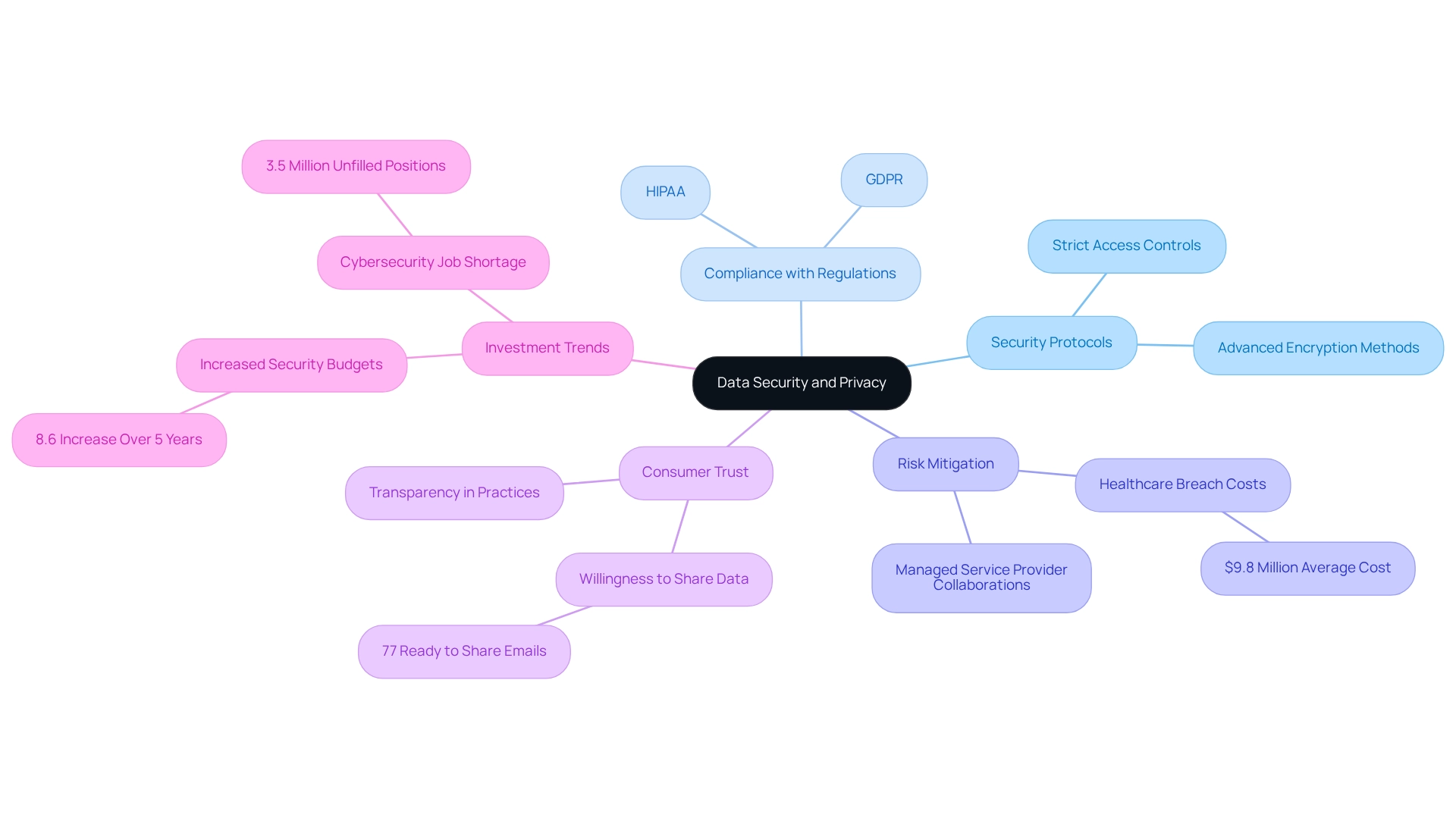
Principle 8: Foster Collaboration Among Stakeholders
Encouraging cooperation among stakeholders is vital for the success of application integration architecture. We must establish clear communication channels and collaborative frameworks that invite input and feedback from all relevant parties, including IT teams, business units, and external partners. By involving stakeholders throughout the unification process, we ensure that varied viewpoints are taken into account, leading to more efficient solutions and a greater likelihood of achieving unification goals.
Statistics reveal that effective teamwork can significantly enhance project outcomes; for instance, nearly 60% of employees believe that organized guidelines on collaboration tools could improve work-life balance, particularly in collaborative projects where clear communication is essential. Furthermore, IDC reported that 48% of companies plan to increase their budgets for collaboration software, underscoring the growing recognition of its importance, especially in the banking industry, where secure and efficient connections are crucial.
Successful unification projects often rely on best practices in communication, such as regular updates, feedback loops, and the integration of UCaaS and contact center platforms, which are transforming customer experiences in hybrid workplaces. By prioritizing stakeholder engagement and employing effective communication strategies in our application integration architecture, we can navigate the complexities of integration more efficiently and achieve our goals.
Our services, including enterprise architecture and project management, play a critical role in supporting these efforts. As Gustavo Estrada, one of our clients, noted, ‘The organization has the ability to simplify complex projects and deliver results within desired time frames and budget constraints.’ This statement highlights the importance of teamwork in utilizing our dedicated hybrid connection platform and expert services to enhance connectivity efforts and drive business value.
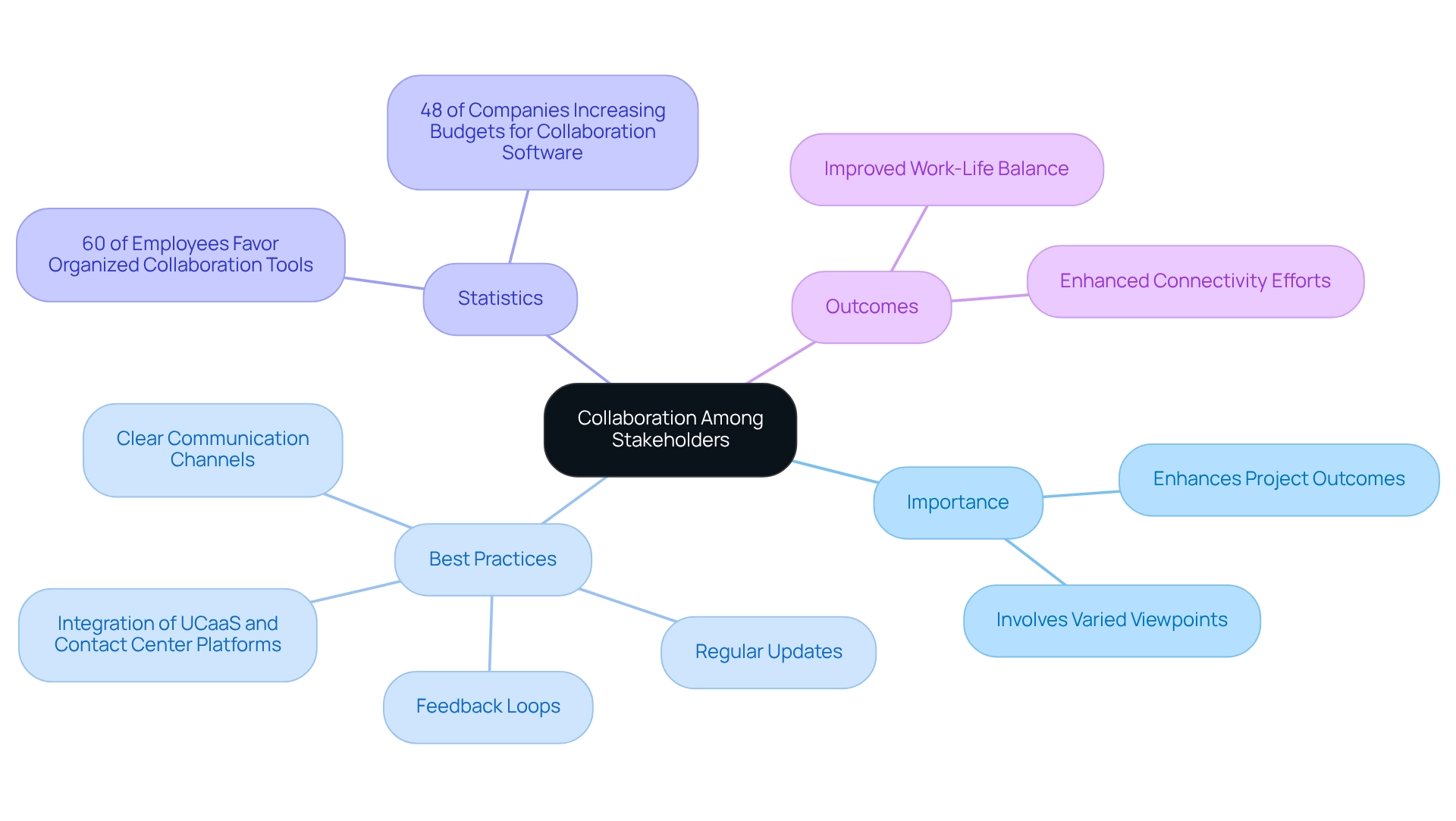
Principle 9: Embrace Continuous Improvement and Adaptation
Ongoing enhancement and adjustment are not just beneficial; they are essential for maintaining an effective application integration architecture. We must routinely assess our merging processes, solicit feedback, and identify areas for improvement. This proactive approach not only aligns our unification efforts with strategic goals but also ensures that we provide continuous value. For instance, companies leveraging customer analytics are 23 times more likely to excel in customer acquisition and 19 times more likely to achieve above-average profitability. This underscores the critical need to improve our unification strategies to meet evolving business requirements.
Current trends indicate that 83% of organizations prioritize product connections, highlighting their vital role in enhancing operational efficiency and sales performance. The rise of generative AI in financial services, evidenced by a 60% increase in its application for customer experience—particularly in developing sophisticated chatbots and virtual assistants—exemplifies how technology can drive engagement and streamline operations. By fostering a culture of ongoing enhancement and efficiently engaging stakeholders, we can adapt to technological advancements and new best practices, ensuring our frameworks remain robust and adaptable. Notably, Starbucks’ loyalty program, which processes over 90 million transactions each week, illustrates how effective coordination can lead to substantial revenue growth—over 25% since its inception. Additionally, John Deere’s IoT sensors and analytics have empowered farmers to increase crop yields by as much as 15%, showcasing the tangible benefits of ongoing enhancement across various sectors.
As Jon Gitlin, Senior Content Marketing Manager, remarked, “It was the same process, go talk to their team, figure out their API. It was taking a lot of time.” This perspective highlights the challenges organizations face in unifying their processes and emphasizes the importance of ongoing enhancement within their application integration architecture to overcome these hurdles. Such examples illustrate the concrete benefits of embracing continuous improvement in application integration architecture, reinforcing how we at Avato assist organizations in maintaining a competitive edge in their respective industries.
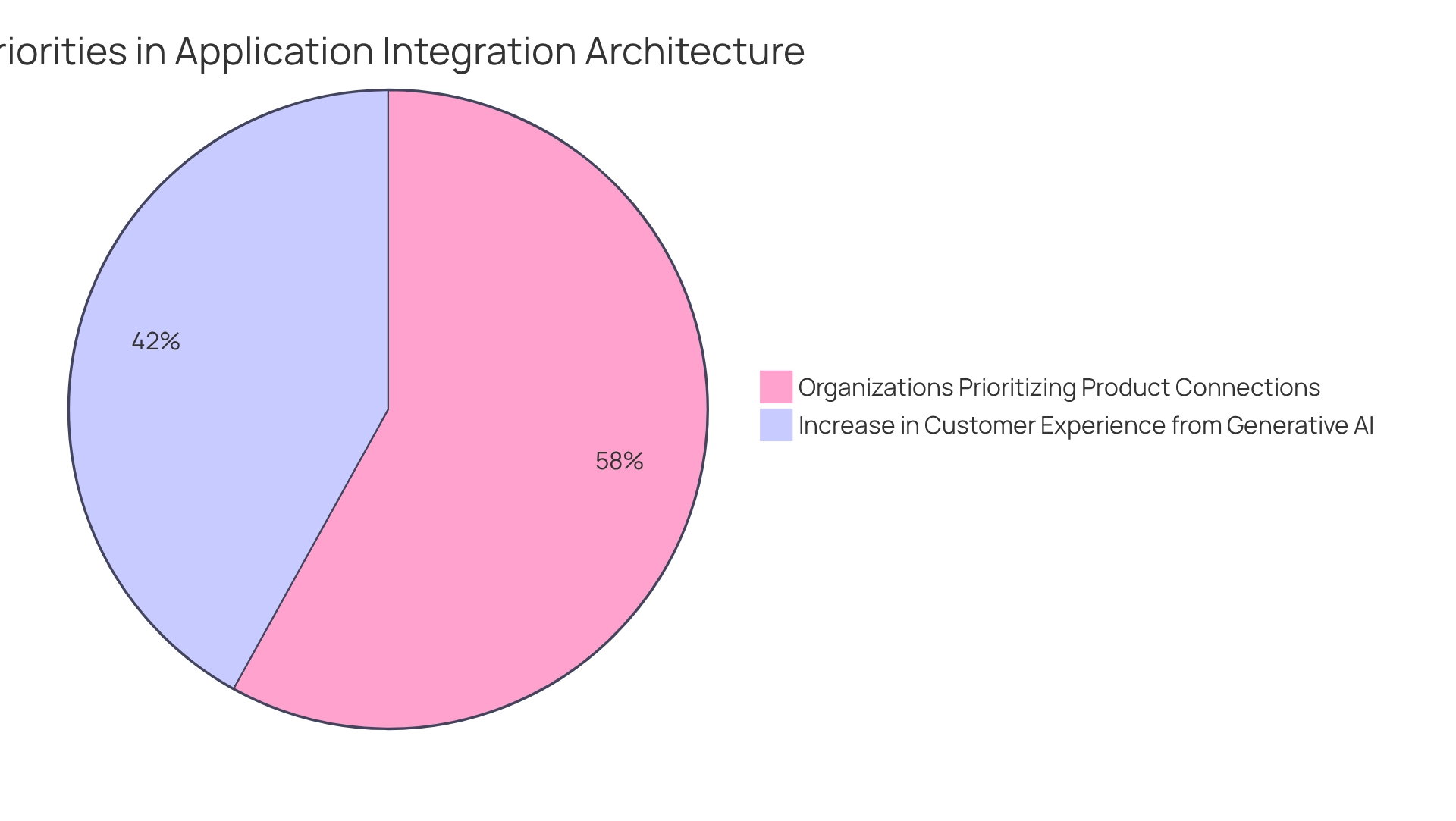
Conclusion
At Avato, we recognize that navigating the complexities of modern integration challenges is vital for organizations aiming to thrive. Our hybrid integration platform provides a robust solution that facilitates secure and efficient connections between disparate systems, empowering sectors such as banking, healthcare, and government to enhance operational efficiency while ensuring compliance with stringent regulations. With the ability to support multiple levels of interface maturity, we enable businesses to adapt swiftly to evolving market demands, thus maintaining their competitive edge.
We emphasize the importance of clear integration objectives, strong governance, real-time monitoring, and the adoption of standardized protocols. These principles not only simplify complex integration processes but also foster collaboration among stakeholders, paving the way for successful outcomes. Moreover, prioritizing data security and integrating automation are essential steps in safeguarding sensitive information and enhancing productivity.
Ultimately, embracing a culture of continuous improvement and scalability positions organizations to respond effectively to future challenges. By leveraging our innovative solutions, businesses can unlock the full potential of their integration efforts, transforming them from mere operational necessities into strategic advantages. The future of integration transcends connectivity; it is about creating a resilient framework that supports growth, efficiency, and innovation. We invite you to partner with us to redefine your integration strategy and achieve lasting success.

